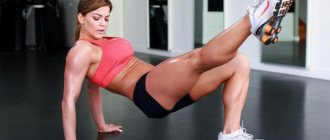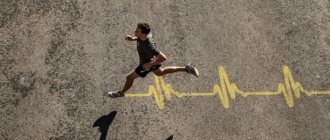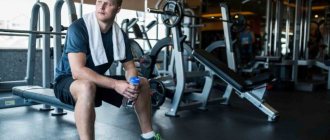Share VK Share FB Share OK
Endurance is the body’s specific ability to resist fatigue. It is characterized by performing movements over a certain period of time without reducing their pace and efficiency.
The efficiency of the body is reduced by two main factors - physical and nervous fatigue. In addition, endurance directly depends on the degree of development of the cardiovascular and respiratory systems.
Endurance is also characterized by the aerobic and anaerobic performance of the body.
Anaerobic energy is produced without the participation of oxygen. Its sources are phosphates and glycogen reserves accumulated in the body (a product of glucose metabolism). Anaerobic energy is produced by the body in very limited quantities and is used for short and intense bursts of activity, with activities lasting up to 4 minutes, after which phosphate and glycogen stores are depleted and aerobic energy begins to be produced.
In turn, anaerobic energy is produced using two mechanisms: creatine phosphate (the maximum of its performance occurs in the second - third seconds of work) and glycolytic (the maximum performance occurs in the first - second minutes of work). The peculiarity of the body’s work is such that each of the energy processes (anaerobic creatine phosphate and glycolytic, as well as aerobic) comes into action sequentially after the capabilities of the previous one are exhausted.
Aerobic energy literally means energy obtained from oxygen. Aerobic energy is the type that is produced during training to develop the cardiovascular and respiratory systems of the body. The body uses aerobic energy during prolonged physical activity. It occurs mainly during the metabolism of carbohydrates and fats with the participation of oxygen.
Aerobic energy production depends on three factors:
- The efficiency of the lungs in receiving oxygen and releasing carbon dioxide.
- The ability of the heart to pump the required amount of oxygenated blood in a certain period of time.
- The ability of the cardiovascular system to supply muscles with oxygen-rich blood.
All three factors are consistently interconnected and are subject to development using the same methods.
Based on the fact that aerobic and anaerobic energy are provided by different mechanisms, they are not interconnected, they serve different purposes, and they are developed, accordingly, by different methods.
Both energy processes – aerobic and anaerobic – are important for mixed martial arts, because a fight in them, as a rule, consists of several rounds lasting two to five minutes each.
The peculiarity of a fight in mixed martial arts is the constantly changing intensity of its conduct from low to
extreme, and the actions of the opponents are divided into a large number of different episodes, alternating with periods of choosing a position, movements, preparation of attacks and transitions to defense, that is, actions of relatively low intensity. Endurance in such work will depend not only on what energy reserves you have and how you will spend them, but also on how quickly they will be restored after episodes of active actions. Intensive execution of attacking and defensive actions is ensured by anaerobic processes, and the speed of recovery during the fight is determined by the power of the aerobic process.
Actoprotective agents
It is possible to increase physical endurance without increased consumption of both oxygen and heat generation with actoprotectors. These synthetic substances belong to metabolic non-depleting drugs that are characterized by antihypoxic activity.
An indication for the use of the drug in sports medicine is the tendency to hypoxia, which occurs after intense physical exercise at the preparatory and competitive stages. It is selected individually taking into account tolerance, age, weight and genetic characteristics.
Actoprotectors do not worsen the state of health, but strengthen the psyche and body. Use for an extended period of time is permitted.
There are the following types of medications:
- Tomerzol and Yakton. Promotes energy growth and affects metabolic processes. The course of treatment can be long, since the body's reserves are not depleted.
- Bemitil. A drug that improves energy balance and stamina. Participates in the processes of psychostimulation, protects against hypoxia, and develops resistance under heavy loads. Take in the first half of the day continuously for 10 or 20 days. course after eating 0.5 g 2 r. in a day.
Development of aerobic endurance
Aerobic endurance is effectively trained by general developmental exercises such as running, swimming, and sports games.
Cross training must be included in the athlete’s training program and last from 15 to 30 minutes during one general physical training session. In this case, attention should be paid not only to running as such, but to cross-country running, running at a jagged pace with short accelerations. It is advisable to use various types of weights on the legs and belt during cross-country training.
Another good exercise for developing aerobic performance is jumping rope. Jumping rope is usually included in the warm-up part of the lesson, but additional time can be devoted to this exercise at the end of the workout. As a warm-up on the jump rope, two or three 2-3 minute rounds with twenty to thirty second breaks filled with low-intensity exercises work. When working on it at the end of the workout, five to six rounds are devoted to this exercise. In this case, jumps are performed in a ragged rhythm, with periodic accelerations
For highly qualified athletes, it makes sense to devote separate sessions to cross-country training, bringing the total duration of each of them to 70 - 90 minutes (this includes not only running, but also other general developmental exercises).
How to develop?
To understand what aerobic endurance is and develop it correctly, you need to perform a whole range of different exercises, supplement your diet with special sports supplements and adhere to a certain rhythm of life. Let's consider how this or that factor affects aerobic endurance and how to develop it correctly.
| System | Effect on aerobic endurance | How to develop? |
| Lung tissue development | Increases lung volume, which increases the energy efficiency of all systems and reduces the effect of hypoxia in target muscle tissues. | Train in conditions of constant hypoxia. For this purpose, training in the form of swimming or aerobic training in a hypoxic mask is suitable. Another option would be jogging in the mountains or regular exercise in mountainous areas. |
| Development of the diaphragm muscles | Increases strength and endurance directly by creating myofibrillar hypertrophy, due to which the body adapts to the load at the original intensity, which reduces fatigue. Additionally, it increases the amount of oxygen that lung tissue can absorb in a second. | Train in conditions of constant hypoxia. Swimming, aerobic training in a hypoxic mask, jogging in the mountains or constant exercise in mountainous areas. |
| Targeted development of white fibers | Increases strength and endurance directly by creating myofibrillar hypertrophy. As a result, the body adapts to the load at its original intensity, which reduces fatigue. | Perform all exercises in an initially aerobic mode with a large number of repetitions. If intense work with anaerobic exercise is used as cardio exercise, it is necessary to increase the number of repetitions to the aerobic limit while decreasing the intensity. For example, 100 squats without weight or burpees in a time frame of up to 25-30 minutes |
| General adjustment of energy systems in the body | Increases the energy efficiency of muscle contractions, which allows you to significantly reduce the load, achieving greater endurance by increasing efficiency. | Same as in the paragraph above |
| Cardiac muscle training | Increases the energy efficiency of muscle contractions, which allows you to significantly reduce the load, achieving greater endurance by increasing efficiency. | Performing loads in an uncomfortable pulse mode, at which heart training begins. This is approximately 120-140 beats per minute, that is, 10% above the fat burning zone. To correctly calculate the load on the heart muscle, use the article about cardio loads and purchase a heart rate monitor. |
| Development of neuromuscular communication | Increases the energy efficiency of muscle contractions. This allows you to significantly reduce the load, achieving greater endurance by increasing efficiency. | Constant and monotonous performance of the same actions, thanks to which the body increases the number of neural connections in the brain/spinal cord/target muscle group. |
| Improving vascular elasticity | Increases the amount of oxygen in the blood due to greater pumping of target muscle groups without additional oxidation. The result is increased susceptibility and increased peak intensity at which aerobic activity becomes anaerobic. | Taking special sports supplements, multivitamins and minerals that are responsible for the elasticity of blood vessels. |
| Increased creatine phosphate in the blood | Increases the susceptibility of white muscle tissue to oxygen starvation. Creatine phosphate allows you to painlessly perform triglyceride breakdown of adipose tissue with increased pumping in a specific target group of muscle tissue. | Taking special sports supplements based on this amino acid in combination with fast grape carbohydrates. |
Development of anaerobic endurance
During the fight, the athlete performs active work (at the same time in a ragged rhythm) for 2 - 3, less than 5 minutes. At the same time, the fight consists of several rounds, which are alternated with fairly long (1 minute) rest periods. Thus, the anaerobic performance of the body becomes of utmost importance for a fighter.
Methods for developing anaerobic endurance are extremely diverse and differ in the nature of the impact on the training ability. In any case, the exercise aimed at developing anaerobic performance is performed for one to four minutes.
The most common method of developing anaerobic performance through general means is circuit training. In this case, each exercise is performed with your own weight at the maximum pace, for example:
- push-ups while lying down with a jump;
- pull-ups on the bar;
- lifting the torso and legs while lying on your back;
- deflections in the lower back when lying on your stomach;
- jumping out of a squat.
The number of repetitions in each exercise is 10–12. 2–4 series of 3 specified complexes are performed in each.
Pauses between complexes in one series are 10–15 seconds, and between series – from one to three minutes and are filled with breathing exercises and shaking movements of the limbs. At the same time, it is necessary to strive to constantly reduce the time required to complete each series.
Development of special endurance
Aerobic and anaerobic performance of the body is the basis for the development of special endurance, because During the fight, both anaerobic and aerobic processes are involved. Special endurance is developed with the help of simulation exercises, when working on apparatus, as well as in training, conditional and freestyle fights.
Effective ways to develop this type of endurance are the following special training exercises:
- Working on a bag with short-term accelerations. The athlete, performing random blows on the bag at an average pace for 3 to 4 minutes, applies short-term accelerations lasting from 10 to 20 seconds. During this time, blows are delivered at maximum speed;
- Intermittent training. With this method of training, the athlete works on the apparatus at a high pace for 1 minute, followed by a period of active rest (light work in the air at a low pace, practicing movements) lasting 2 - 3 minutes. Thus, the athlete must complete at least four to five one-minute rounds in one series;
- Extended round. The structure of the exercise is similar to the previous one. In this case, 5 segments lasting 30–40 seconds are combined into one round, during each of which the athlete works on the apparatus at a near-maximum pace. Such rounds alternate with ten to fifteen second pauses;
- Extended round. From time to time, in order to develop the athlete’s “margin of safety,” when working in pairs and on apparatus, rounds are used that are longer than those provided for by the competition rules. So, if the duration of a sports match is 3 minutes, the athlete is given the task to work for 3.5 - 4 minutes without reducing the set pace with periodic accelerations.
An important point in developing endurance is the economization of a fighter’s activities during a fight. An athlete who spends less effort when performing techniques and movements than his opponent can endure the load of a fight for a longer period of time, resisting fatigue more effectively. To improve an athlete's ability to perform work more economically, a number of special methods are used during training fights.
A method of prolonged fighting of medium or below-average intensity . At the same time, tasks are given to conduct fights that are 2 to 6 times longer than the duration of fights at competitions. The fighter must independently distribute his forces for this period.
Long fights lead to the fact that the athlete directs all his attention to maintaining strength until the end of the fight, trying not to use actions that require large amounts of energy.
The method of fighting a tired fighter with an untired fighter. In this case, the athlete must consistently carry out several fights in a row with changing fresh opponents. The entire fight as a whole may take more time than provided for by the competition rules, or the same amount. The athlete should strive to fight actively, without switching to passive defense. The partner can change every 1 - 1.5 minutes. A variant of this method is when during one (for example, three-minute) round, “fresh” opponents change every minute. In this case, the fighter must spend the first or first and second one-minute periods sparingly, and the last one in an aggressive attacking manner. This option, in addition to developing endurance and the ability to rationally distribute forces, also trains the tactical component of sportsmanship.
A fight with the task of tiring the enemy. In this case, the athlete is given the task of tiring the opponent to such a state that he cannot continue the fight. This task can be solved either in a separate battle or in battle with changing opponents. In the latter case, the fighter must conduct the fights in such a way that the opponents, as a result of fatigue, one after another refuse to continue.
Fight for a shorter time until a clear victory. Such fights allow you to achieve victory in a short time and thereby save energy for the next fights that need to be fought during the competition. Typically, such tasks are given in battles between more experienced fighters and less experienced ones. The less experienced fighter, accordingly, is given the task of holding out as long as possible and not allowing the experienced opponent to win cleanly. A coach can challenge an athlete to win a fight with a specific action or set of actions. For example, to win a fight only with the help of a painful or choking technique, or to carry out a series of precise blows, thus simulating a victory by knockout. In the latter case, reliable protective equipment must be used, and the coach must carefully monitor the course of the fight, avoiding actions that could lead to injury.
Body adaptability
During rational endurance training, changes occur in many parts of the body. In addition to adaptation in the lungs and heart, after the intensive training phase there also follows adaptation of the blood in the peripheral circulation. In the lungs, for example, the breathing area and the network of pulmonary capillaries expand so that the lung capacity increases. The volume of the heart increases and can transport more oxygen through the heartbeat. The number of transporters, red blood cells, increases in the blood, thereby ensuring high oxygen exchange. Further, muscle volume also increases due to improved capillarization.
Speed endurance
Speed endurance is a type of special endurance, which is characterized by a person’s ability to perform movements at maximum speed for a relatively long time without reducing work efficiency. Speed endurance manifests itself when it is necessary to perform a series of attacking or defensive actions. It is determined by the anaerobic productivity of the body and develops during the performance of exercises of the specified orientation with short-term accelerations.
Results and conclusions
Increasing endurance is complex and time-consuming work. When training technique and strength, it can sometimes be very difficult to determine the level of endurance of an athlete. Often there is simply no time for flexible endurance training or priorities are in other areas.
And yet, developing endurance is included in the training program of every judoka. It is very important not to consider it in isolation and not to associate its development only with classical sports that require endurance (for example, running and playing sports). Using the means of our sport - judo, we also have ample opportunities to improve general and special endurance.
Strength endurance
Strength endurance is a specific manifestation of two motor abilities at the same time - endurance and strength. It is characterized by the ability to perform movements with significant external resistance over a certain period of time without reducing their effectiveness (compare with the general definition of endurance). Strength endurance is directly related to general endurance, but differs from it primarily in the strength nature of the work.
Based on the fact that strength endurance is characterized by the presence of significant external resistance, it is most clearly manifested when working in grappling, wrestling in a standing position and on the ground. Strength endurance, being a special type of endurance in mixed martial arts, is also characterized by an anaerobic type of body work.
There are two main ways to develop special endurance: performing exercises with relatively light weights “all the way” and using the circular training method. In the first case, we are talking about weights that allow you to perform no more than 15–20 repetitions per set at an average pace.
At the same time, strength endurance is most effectively developed by circuit training. One complex includes 5–7 strength exercises for various muscle groups, which are performed sequentially without rest or with a short (up to 20 seconds) pause between them. As a rule, exercises with an overcoming mode of work are used, in which weights of 60–70% of the maximum are used. In this case, the exercises in the complex are selected randomly with one requirement: each of the exercises must affect one of the main muscle groups.
So, it is recommended to perform the following complex:
- bench press;
- pull-ups on the bar;
- lifting the body from a supine position with additional weights;
- squats.
In each exercise, 8 - 10 repetitions are performed, and in the exercise indicated in paragraph c - 15 repetitions. 3 series of three such complexes are performed in each series. The break between complexes is up to 20 seconds, between series – up to 1.5 minutes.
In addition, special strength endurance, which is extremely important when wrestling on the ground, develops during training and conditional wrestling matches, especially with a heavier opponent.
Is it possible to train at home?
Of course, you can also develop endurance and breathing at home. How to do this without special equipment and simulators?
For those who are just starting their journey into the world of athletics and sports, home complexes from professional trainers are very effective. You don’t have to buy them for money at all - there are many free training examples. To begin with, you should opt for workouts in the work-out style for beginners. The sequence is something like this:
- light joint warm-up;
- leisurely running in place will speed up your heart rate and make your breathing quicken;
- performing plyometric exercises - burpees, jumping lunges, jumping lunges, jumping with a turn, but active execution should be alternated with a minute's rest;
- in the middle of the workout, you should switch to a low-intensity pace of exercise, for example, do a set of crunches or squats with a body bar;
- repeat the cycle of plyometric exercises again in the following rhythm: five minutes of activity - one minute of rest several times.
The main principle of training is changing the intensity of movements. This will allow you to develop endurance and breathing. How to do this as efficiently as possible without harming yourself? You will read about this below.











